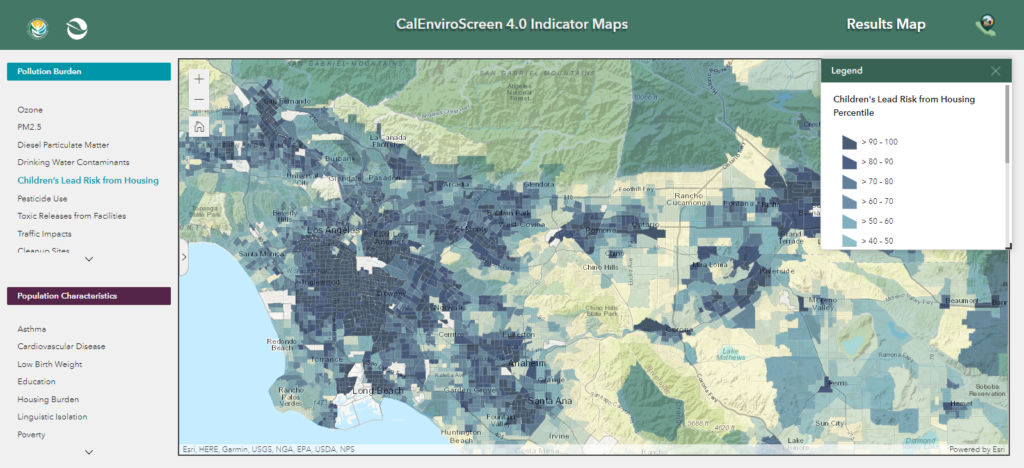CalEnviroScreen’s New Lead Exposure Factor: What it Tells Us and What it Doesn’t
Clarence Vong | March 7, 2023

As the housing market tightens, there are fewer homes for prospective buyers. Home buyers have two choices. Buyers may choose buy a newer home without the need for remodeling. Or buyers may choose to purchase an older home, move in as is, or remodel it to their liking. Older homes offer historic qualities which are appealing to some buyers, and they are often less expensive than newer homes. However, there is something lurking within these older homes. The presence of lead is one of the factors many new home buyers overlook. Depending on various factors, lead can pose a serious health risk to inhabitants, particularly young children.
Fortunately, for residents in California, the State has made information about potential exposure to lead through their online tool, CalEnviroScreen. This science-based screening tool helps identify harmful pollution exposure within California. CalEnviroScreen identifies California communities that are most affected by many sources of pollution, and where people are often especially vulnerable to pollution’s effects. The tool draws data from exposures, public health, environmental effects, sensitive populations, and socioeconomic effects to understand the cumulative impacts some communities may face due to exposure to multiple pollutants. The tool scores census tracts using percentile rankings, ranging from 0 to 100, which compares the tract with all other census tracts in the state. For example, a census tract in the 89th percentile, would have a higher pollution burden than 89% of all census tracts in the state. The model looks at 13 different pollution factors in calculating a census tract’s pollution burden score. Calenviroscreen 4.0, released in October 2021, was the first iteration that included children’s lead risk from housing.

Why is Lead Exposure Important?
Lead, even at low levels, can affect human health. Children are especially vulnerable because they are still developing and are often most exposed to lead. Lead has been found to contribute to behavior problems, learning problems, lower intelligence, and increased hyperactivity. Above all, lead’s ability to mimic and disrupt essential molecules in the body can have devastating effects on the brain and other organs. Lead doesn’t have any place in the body, like other elements such as iron or calcium. However, because it can mimic calcium, lead can be absorbed into the brain to disrupt the movement and storage of calcium inside cells. Increased cell stress can lead to the early death of neurons and brain cells. This can be particularly devastating in early childhood, when the brain is still developing.
In addition to the brain, lead can affect other parts of the body. Lead can enter the heart and blood vessels, which can also increase the risk of high blood pressure, coronary artery disease, and possibly stroke. Lead can also accumulate in the bones over time. When a pregnant woman lacks dietary calcium, they release calcium from their bones to help form the bones of the fetus. Lead accumulated in bones can affect the development of the fetus, as it mimics the flow of calcium. As a result, lead exposure during pregnancy can lead to reduced fetus growth and premature birth.
Pathways for Lead to Enter the Body
According to the Center for Disease Control, lead exposure occurs primarily through ingestion, that is the swallowing of something containing lead. Lead-based paint, common in housing in the United States before 1978, exposes lead as it deteriorates, peels, chips or crumbles due to friction, such as when windows open or close. Dust inside the home or soil outside may become contaminated with lead particles that are ingested through hand-to-mouth activity. Children are among the most vulnerable to this exposure pathway through normal play inside or outside the house.
Ingestion by consuming water is a concern in older communities where lead was common in pipes, and has been highlighted in several high profile large-scale contamination events such as Flint, Michigan and Newark, New Jersey.

Although lead in gasoline fuel was phased out decades ago in the United States, research has still found that many older urban areas continue to be contaminated with residual lead, particularly in areas with high traffic, such as near freeways. The presence of this lead in urban soils invites ingestion and inhalation through working the soil when gardening, playing, or during construction.
Exposure to lead used in industry can also be a concern for some workers, or some communities where air-borne exposure has resulted in inhalation or ingestion of lead, such as the case with the Exide Technologies battery recycling plant in Vernon, CA. These exposure risks tend to be more isolated than broader exposure due to the use of lead paint, via drinking water systems, or from the legacy usage of leaded gasoline.
What Exposure Pathways does CalEnviroScreen Consider?
Although there are multiple pathways that can expose children to lead, CalEnviroScreen newest factor focuses only on exposure to lead through paint. The model has included a drinking water contamination factor for several years, that includes exposure to lead via drinking water, based on the EPAs Lead and Copper Rule. In addition, factors such toxic releases and cleanup sites may account for exposure to lead used in industry.
While the ultimate measure of exposure may be date on elevated blood levels among children, this data is limited as universal testing of lead levels in children is not required in California. CalEnviroscreen 4.0 documentation notes that factors such age of housing, income, race, and enrollment in public assistance programs have historically been used to estimate exposure risk. However data for only two of these variables is readily available: Age of housing stock and children living in low-income households. As a result, the indicator used in the CalEnviroScreen 4.0 model is the percentage of households within a census tract with likelihood of lead-based paint hazards from the age of housing combined with the percentage of households that are both low-income and have children under 6 years old. Although data on race is readily available, and has been shown to be a factor in elevated exposure, CalEnviroScreen does not include it in the indicator. Since its first release, Race/ethnicity has been excluded from the indicators in CalEnviroScreen.
An Incomplete Picture of Lead Exposure
As with many CalEnviroScreen factors that predict the likelihood, or risk of exposure, there is the potential for users to misinterpret the findings. Living in a census tract with a high percentile ranking in terms of children’s lead risk from housing does not necessarily mean that your family is being exposed. It means that due to the age of homes and the prevalence of low-income children increases the possibility that such exposure may occur. Similarly, if you reside in a house built before 1978 within a neighborhood with low percentile ranking, your family may still be at risk of exposure. And while lead exposure in water systems and from local industry is included in other variables in the model, these are details that may be lost on the public accessing this information. Given the high-profile nature of recent cases of wide-scale exposure and the prevalence of lead water lines in California, it may be important to provide greater clarity about how different exposure pathways are being addressed in CalEnviroScreen.
Finally, exposure resulting from the legacy usage of leaded gasoline is not explicitly addressed in CalEnviroScreen and research shows this remains a substantial risk in some communities. The inclusion of traffic density as a factor in the model may provide some indicator of risk, however the role of lead in this factor is not explicitly addressed in the documentation and this factor uses recent traffic density data as opposed to historic patterns when leaded gasoline was in use.
Although lead-based paint was banned in 1978, lead remains in millions of older homes. Buying a newer house tends to cost more than a older house , so exposure risk is likely to be greater for those with lower financial means. The estimated cost to remove lead-based paint would significantly exceed the average homeowner’s willingness-to-pay. So this is a risk that will likely continue in these communities well into the future.

Clarence Vong holds a bachelor’s in Interior design and is currently pursuing his master’s in the CPP MLA program. He hopes to use his interdisciplinary background to create environmentally friendly designs and reduce waste. He was inspired to study Landscape architecture due to his current job, which allows him to design site plans. After graduating, he would like to work under a licensed Architect to pursue his licensure.